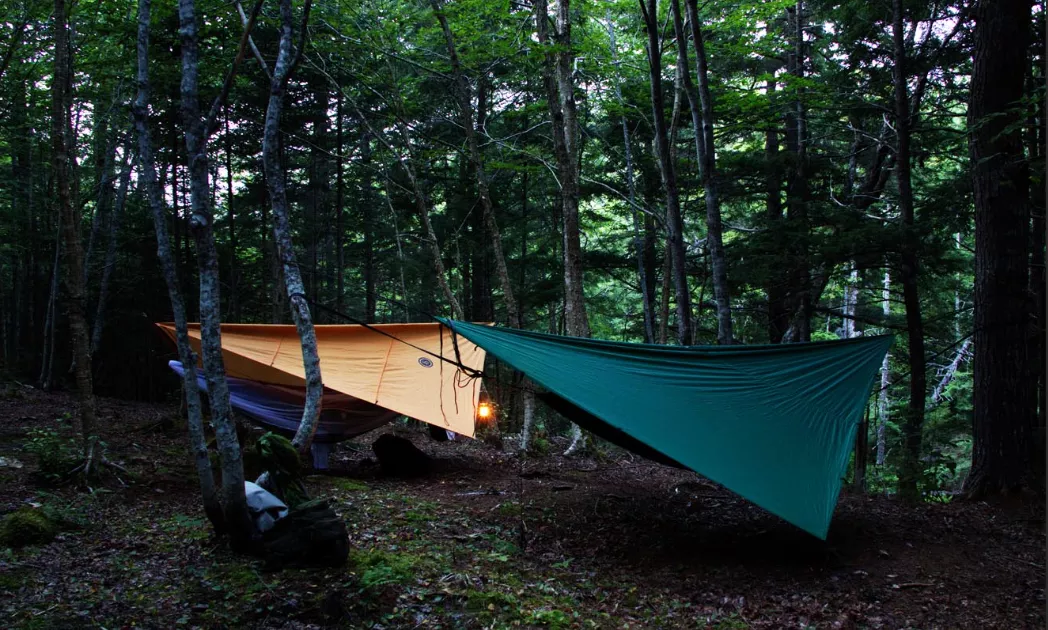Hammock camping offers a unique and comfortable way to experience the great outdoors. Whether you’re a seasoned camper or a novice, understanding the essential gear and setup for hammock camping is crucial. This guide will provide you with a detailed overview of what you need for a successful hammock camping trip, ensuring you’re well-prepared for your adventure.
1. Choosing the Right Hammock
Material and Construction
When selecting a hammock, the material and construction are crucial. Hammocks are typically made from nylon, polyester, or a blend of these materials.
Nylon is lightweight and durable, ideal for most conditions.
Polyester is more resistant to UV damage and less prone to stretching.
Blends offer a combination of the benefits of both materials.
Size and Weight Capacity
Hammocks come in various sizes. Choose a hammock that fits your body size and weight. Single hammocks are suitable for one person, while double hammocks provide extra space or can accommodate two people.
Single Hammocks: Typically 4-5 feet wide and 7-9 feet long.
Double Hammocks: Generally 5-7 feet wide and 9-11 feet long.
Ensure the hammock’s weight capacity exceeds your body weight for safety and comfort.
SEE ALSO: The 10 Best Sleepaway Camps
2. Suspension System
Types of Suspension Systems
A proper suspension system is vital for hanging your hammock securely. Common types include:
Tree Straps: Wide, flat straps that wrap around trees. They prevent damage to the bark and distribute weight evenly.
Ropes: Thin and strong, but they can damage tree bark. Use them with caution and consider tree-friendly options.
Setting Up Your Suspension
Tree Straps: Wrap around the tree at chest height and adjust the hammock’s height accordingly.
Ropes: Tie knots securely and adjust the length to achieve the desired hammock height.
Ensure your hammock is level and provides a comfortable angle for sleeping.
3. Hammock Tarp
Purpose and Types
A hammock tarp provides shelter from rain and wind. There are several types:
Hex Tarp: Offers more coverage and is suitable for varying weather conditions.
Catenary Cut Tarp: Features curved edges that reduce weight and provide excellent water runoff.
Flat Tarp: Simple and versatile, though it may require additional setup for effective weather protection.
Setting Up Your Tarp
A-Frame Setup: Position the tarp over the hammock and secure it with stakes or guy lines. This setup provides excellent coverage and stability.
Flying Diamond Setup: Create a diamond shape with the tarp, offering minimal coverage but reducing weight.
Ensure the tarp is pitched high enough to avoid contact with the hammock and low enough to protect from wind and rain.
4. Underquilt and Sleeping Bag
Underquilt
An underquilt is designed to keep you warm by insulating the underside of the hammock.
Materials: Choose from down or synthetic fill. Down is lighter and more compressible but less effective when wet. Synthetic fill performs better in damp conditions.
Attachment: Most underquilts attach to the hammock using clips or elastic cords. Ensure it is snug against the hammock to prevent cold spots.
Sleeping Bag
Select a sleeping bag based on the expected temperatures.
Mummy Bags: Offer excellent warmth but may be restrictive.
Rectangular Bags: Provide more space but may be less efficient in retaining heat.
Choose a sleeping bag with a temperature rating suitable for the season and your comfort level.
5. Bug Protection
Bug Net
A bug net is essential for keeping insects away from your hammock.
Integrated Net: Some hammocks come with an integrated bug net, providing convenience and complete coverage.
Separate Net: Available as an accessory, it attaches to the hammock or suspension system.
Ensure the net is large enough to cover the entire hammock and is free from holes.
6. Comfort and Additional Gear
Pillow and Sleeping Pad
For added comfort, consider bringing a pillow or sleeping pad.
Pillow: A small, inflatable pillow or stuff sack filled with clothes can enhance head and neck support.
Sleeping Pad: Provides extra insulation and cushioning. Choose a lightweight, inflatable pad for easy packing.
Footwear and Clothing
Wear appropriate clothing and footwear for your camping environment.
Footwear: Lightweight, waterproof boots or sandals are ideal for varying terrains.
Clothing: Layered clothing allows you to adjust to changing temperatures. Include moisture-wicking and quick-drying materials.
Camp Accessories
Additional accessories can improve your camping experience:
Headlamp or Lantern: Provides light for nighttime activities.
Cooking Gear: A compact stove, cookware, and utensils for meal preparation.
First Aid Kit: Essential for handling minor injuries or illnesses.
7. Setting Up Your Campsite
Choosing a Campsite
Select a campsite with flat, level ground. Avoid setting up near water sources or on slopes. Look for a location with suitable trees or anchor points for your hammock.
Hanging Your Hammock
Distance Between Trees: Aim for a distance of 10-15 feet between trees.
Hammock Height: The hammock should be 18-24 inches off the ground for ease of entry and exit.
Ensure the hammock is taut but not too tight. The ideal hang angle is around 30 degrees from horizontal.
8. Safety Considerations
Tree Health
Choose healthy, sturdy trees with thick bark. Avoid trees with loose bark, dead branches, or signs of disease.
Weather Conditions
Monitor weather conditions before setting up. Be prepared for sudden changes and ensure your gear is suitable for the expected weather.
Leave No Trace
Follow Leave No Trace principles to minimize your impact on the environment. Pack out all waste and avoid damaging vegetation.
Conclusion
Hammock camping is a rewarding and enjoyable way to experience nature. By understanding and preparing with the right gear, you can ensure a comfortable and safe camping experience. From choosing the right hammock to setting up your campsite, each step is crucial for a successful hammock camping adventure. Equip yourself with the knowledge and gear outlined in this guide, and enjoy the freedom and comfort of hammock camping.


